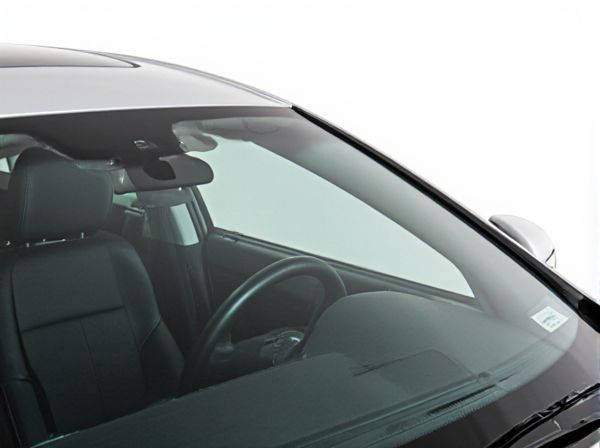
Photo illustration: Gorilla Glass vs Standard Glass Windshield
Gorilla Glass offers superior durability and scratch resistance compared to standard glass windshields, enhancing the longevity of your vehicle's front protection. Its lightweight composition contributes to better fuel efficiency and improved handling without compromising safety. Choosing Gorilla Glass ensures a stronger, clearer windshield that resists cracks and chips more effectively in everyday driving conditions.
Table of Comparison
| Feature | Gorilla Glass Windshield | Standard Glass Windshield |
|---|---|---|
| Material Composition | Aluminosilicate glass with chemical strengthening | Laminated soda-lime glass |
| Durability | Highly scratch-resistant and impact-resistant | Moderate resistance, prone to chips and scratches |
| Weight | Lighter by up to 20% enhancing fuel efficiency | Heavier, adds to vehicle weight |
| Clarity | Superior optical clarity with less distortion | Standard optical clarity |
| Cost | Higher upfront cost due to advanced manufacturing | Lower initial cost, widely available |
| Lifespan | Longer lifespan with excellent resistance to wear | Shorter lifespan, often requires replacement |
| Safety | Better impact absorption and crack resistance | Standard safety performance |
Introduction to Gorilla Glass and Standard Glass Windshields
Gorilla Glass windshields are made from chemically strengthened aluminosilicate glass, offering superior scratch resistance and enhanced durability compared to standard glass windshields, which are typically composed of laminated or tempered soda-lime glass. Standard glass windshields prioritize impact resistance and shatter protection but are more prone to scratches and chips over time. Gorilla Glass technology provides a thinner, lighter alternative without compromising strength, improving vehicle safety and fuel efficiency.
Composition and Manufacturing Differences
Gorilla Glass is an alkali-aluminosilicate sheet glass chemically strengthened through an ion-exchange process, which replaces smaller sodium ions with larger potassium ions to create a compressive stress layer enhancing toughness and scratch resistance. Standard glass windshields are typically laminated safety glass made by bonding two layers of annealed glass with a polyvinyl butyral (PVB) interlayer, providing shatter resistance but lower impact durability compared to chemically strengthened glass. Manufacturing Gorilla Glass involves controlled melting, ion-exchange baths, and precise thermal treatments, whereas standard glass uses float glass production followed by lamination and curing processes.
Strength and Durability Comparison
Gorilla Glass offers significantly higher strength and durability compared to standard glass windshields due to its chemically strengthened composition, which provides enhanced resistance to impacts and scratches. Its thin, lightweight design improves vehicle safety by reducing shatter risks and maintaining structural integrity under stress. Standard glass windshields are more prone to cracks and chips, requiring frequent replacement, whereas Gorilla Glass extends lifespan and reduces maintenance costs.
Weight and Thickness Analysis
Gorilla Glass windshields are significantly lighter than standard glass, reducing vehicle weight by up to 30%, which enhances fuel efficiency and handling. The thickness of Gorilla Glass ranges from 0.4 to 1.2 millimeters, considerably thinner than traditional automotive glass that typically measures 2.5 to 4 millimeters. Despite its reduced thickness and weight, Gorilla Glass maintains superior strength and impact resistance through advanced chemical strengthening processes.
Scratch and Impact Resistance
Gorilla Glass windshields provide superior scratch resistance compared to standard glass due to their chemically strengthened aluminosilicate composition, which enhances surface durability. The impact resistance of Gorilla Glass is notably higher, offering improved protection against chips and cracks from road debris and minor collisions. Standard glass windshields, typically made from laminated soda-lime glass, are more prone to scratches and shattering under impact, resulting in lower durability and increased maintenance costs.
Clarity and Optical Performance
Gorilla Glass windshields offer superior clarity and optical performance compared to standard glass, featuring enhanced scratch resistance and reduced distortion for clearer visibility. The chemically strengthened structure of Gorilla Glass minimizes light refraction and glare, providing sharper, more accurate views of the road. Standard glass, while durable, often lacks the advanced coatings and structural integrity that optimize optical clarity under various lighting conditions.
Cost and Affordability Factors
Gorilla Glass windshields offer superior durability and scratch resistance compared to standard glass, but their higher manufacturing costs result in significantly increased replacement prices. Standard glass windshields are more affordable and widely available, making them a cost-effective choice for most vehicle owners. Insurance premiums may also be higher for vehicles with Gorilla Glass due to the expense of repairs and replacements.
Compatibility With Vehicle Models
Gorilla Glass windshields offer enhanced compatibility with modern vehicle models due to their lightweight and flexible properties, enabling easier integration with sleek automotive designs. Standard glass windshields, while compatible with a wide range of traditional vehicles, may require additional support structures in advanced models to meet safety standards. Compatibility considerations include factors such as curvature, thickness, and sensor integration, where Gorilla Glass often excels in accommodating advanced driver-assistance systems (ADAS).
Repair, Replacement, and Maintenance Considerations
Gorilla Glass windshields offer superior scratch resistance and enhanced durability compared to standard glass, reducing the frequency of repairs and maintenance. While Gorilla Glass can be more expensive to replace, its strength helps prevent minor chips from turning into major cracks, potentially lowering long-term replacement costs. Standard glass windshields tend to be easier and cheaper to repair but are more prone to damage, requiring more frequent maintenance and eventual replacement.
Future Trends in Automotive Windshield Technology
Gorilla Glass offers superior scratch resistance, lighter weight, and enhanced durability compared to standard glass windshields, making it ideal for next-generation automotive applications. Future trends highlight augmented reality (AR) integration and advanced sensor embedding, where Gorilla Glass's thin, robust properties enable seamless heads-up displays and improved safety features. Automotive manufacturers increasingly adopt chemically strengthened glass to reduce vehicle weight and enhance fuel efficiency without compromising windshield performance.
 caratoz.com
caratoz.com